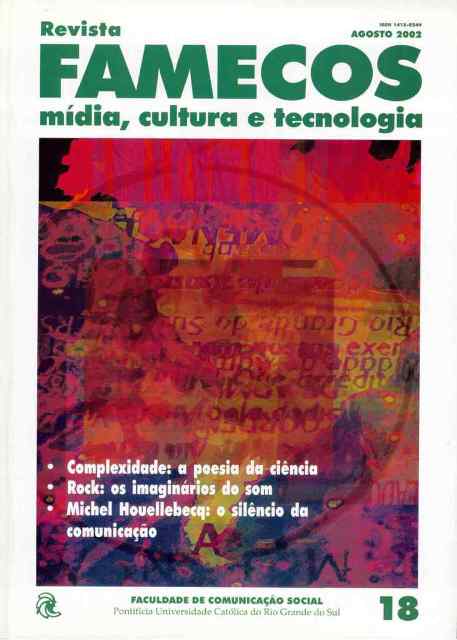Tecnognose: virtual technologies, spiritual identity and imagination
DOI:
https://doi.org/10.15448/1980-3729.2002.18.3164Keywords:
Communication, imaginary, religionAbstract
The article seeks to investigate the roots of the connections that the contemporary cultural imaginary establishes between technology and spirituality. It analyzes the diverse representations that associate the technologies of the virtual with the religion, in particular the forms of Gnostic religiosity, as well as it suggests a taxinomy of the symbols and myths that circulate in the literature specialized in the subject and by the universe of the cyberculture.
Downloads
References
ADORNO, Theodor; HORKHEIMER, Max. Dialektik der Aufklärung. Frankfurt am Main: Fischer, 1975.
______. Minima Moralia. Madrid: Taurus, 1987.
BLOOM, Harold. Omens of Millenium: the Gnosis of Angels, Dreams, and Resurrection. New York: Riverhead Books, 1996.
BLUMENBERG, Hans. Work on Myth. Cambridge: The MIT Press, 1990.
BUKATMAN, Scott. Terminal Identity: the Virtual Subject in Post-Modern Science-Fiction. Durham: Duke University Press, 1993.
CALABRESE, Omar. A Idade Neobarroca. Lisboa: Edições 70, 1988.
______. (org.).Antropologia do Ciborgue: as Vertigens do Pós-Humano. Belo Horizonte: Autêntica, 2000.
DAVIS, Erik. Techgnosis: Myth, Magic+ Mysticism in the Age of Information. New York: Three Rivers Press, 1998.
FAIVRE, Antoine. Accés de lʼÉsotérisme Occidental. Paris: Gallimard, 1986.
FERRAZ, Maria Cristina Franco. Sociedade Tecnológica: de Prometeu a Fausto. Contracampo, Niterói, n. 4, jan. 2000.
FOUCAULT, Michel. Les Mots et les Choses. Paris: Gallimard, 1996.
FRIEDMAN, Richad Elliot. The Disappearance of God. Boston: Little, Brown & Company, 1995.
GROYS, Boris. A Guinada Metafísica de Hollywood. Folha de São Paulo, São Paulo, 3 jun. 2001. Caderno Mais!
GUMBRECHT, Hans Ulrich. Living at the Edge of Time. Cambridge: Harvard University Press, 1997.
HAYLES, N. Katherine. How we became Posthuman: Virtual Bodies in Cybernetics, Literature and Informatics. Chicago: University of Chicago Press, 1999.
LIEB, Michael. Children of Ezekiel: Aliens, UFOs, the Crisis of Race and the Advent of End Time. Durham: Duke University Press, 1998.
MARRAMAO, Giacomo. Poder e Secularização: as Categorias do Tempo. São Paulo: Unesp, 1995.
MORSE, Margaret. Cyberscapes, Control and Transcendence: the Aesthetics of the Virtual. Bloomington: Indiana University Press, 1998.
NOBLE, David. The Religion of Technology: the Divinity of Man and the Spirit of Invention. New York: Penguin, 1999.
RÜDIGER, Francisco. Literatura de Auto-Ajuda e Individualismo. Porto Alegre: Editora da Universidade, 1995.
SAN JUAN DE LA CRUZ. Vida y Obras. La editorial católica, Madrid, v. 15, 1960.
SFEZ, Lucien. Crítica da Comunicação. São Paulo: Loyola, 1994.
SILVA, Tomaz Tadeu da (org.). Pedagogia dos Monstros: os Prazeres e Perigos da Confusão de Fronteiras. Belo Horizonte: Autêntica, 2000.
SPENCE, Jonathan. O Palácio da Memória de Matteo Ricci. São Paulo: Círculo do Livro, 1990.
TERRÉ-FORNACCIARI, Dominique. Lês Sirènes de lʼIrrationnel: quand la Science touche à la Mystique. Paris: Albin Michel, 1991.
TURKLE, Sherry. Life on the Screen: Identity in the Age of Internet. New York: Simon & Schuster, 1997.
VOEGELIN, Eric. A Nova Ciência da Política. Brasília: Universidade de Brasília, 1982.
WAITE, Geoff. Nietzscheʼs Corps/e: Aesthetics, Prophecy, or, the Spectacular Technoculture of Everyday Life. Durham: Duke University Press, 1996.
WERTHEIM, Margaret. The Pearly Gates of Ciberspace: a History of Space from Dante to the Internet. New York: W.W. Norton & Company, 1999.
Downloads
Published
How to Cite
Issue
Section
License
Copyright
The submission of originals to Revista Famecos implies the transfer by the authors of the right for publication. Authors retain copyright and grant the journal right of first publication. If the authors wish to include the same data into another publication, they must cite Revista Famecos as the site of original publication.
Creative Commons License
Except where otherwise specified, material published in this journal is licensed under a Creative Commons Attribution 4.0 International license, which allows unrestricted use, distribution and reproduction in any medium, provided the original publication is correctly cited.






